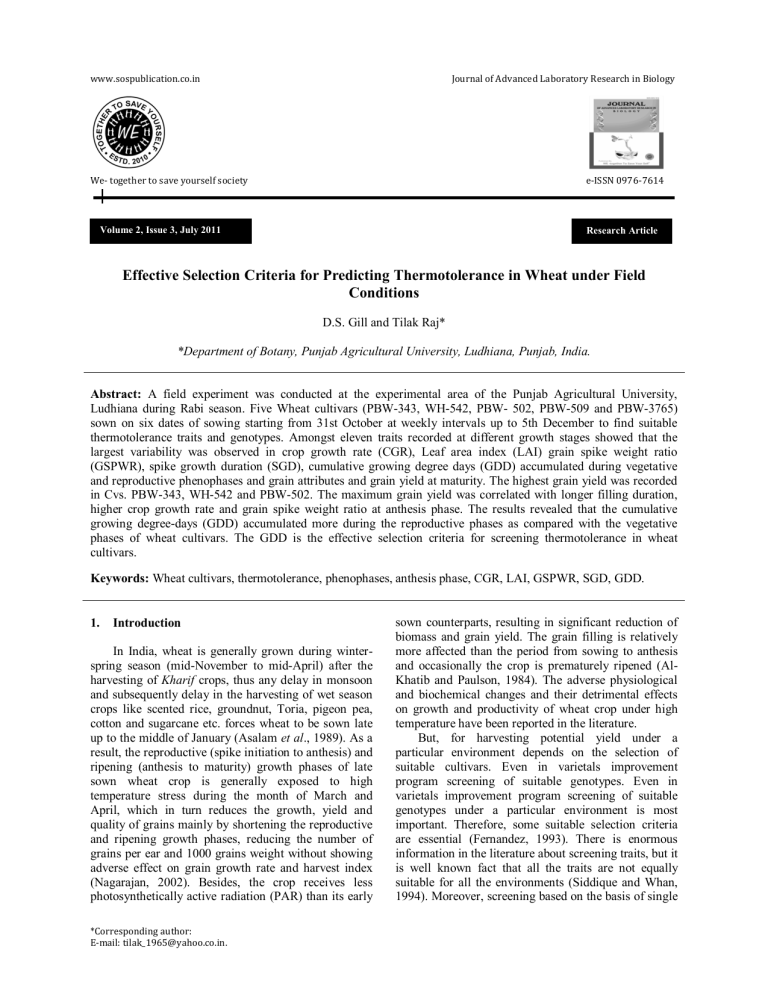Effective Selection Criteria for Predicting Thermotolerance in Wheat under Field Conditions
advertisement

www.sospublication.co.in Journal of Advanced Laboratory Research in Biology We- together to save yourself society e-ISSN 0976-7614 Volume 2, Issue 3, July 2011 Research Article Effective Selection Criteria for Predicting Thermotolerance in Wheat under Field Conditions D.S. Gill and Tilak Raj* *Department of Botany, Punjab Agricultural University, Ludhiana, Punjab, India. Abstract: A field experiment was conducted at the experimental area of the Punjab Agricultural University, Ludhiana during Rabi season. Five Wheat cultivars (PBW-343, WH-542, PBW- 502, PBW-509 and PBW-3765) sown on six dates of sowing starting from 31st October at weekly intervals up to 5th December to find suitable thermotolerance traits and genotypes. Amongst eleven traits recorded at different growth stages showed that the largest variability was observed in crop growth rate (CGR), Leaf area index (LAI) grain spike weight ratio (GSPWR), spike growth duration (SGD), cumulative growing degree days (GDD) accumulated during vegetative and reproductive phenophases and grain attributes and grain yield at maturity. The highest grain yield was recorded in Cvs. PBW-343, WH-542 and PBW-502. The maximum grain yield was correlated with longer filling duration, higher crop growth rate and grain spike weight ratio at anthesis phase. The results revealed that the cumulative growing degree-days (GDD) accumulated more during the reproductive phases as compared with the vegetative phases of wheat cultivars. The GDD is the effective selection criteria for screening thermotolerance in wheat cultivars. Keywords: Wheat cultivars, thermotolerance, phenophases, anthesis phase, CGR, LAI, GSPWR, SGD, GDD. 1. Introduction In India, wheat is generally grown during winterspring season (mid-November to mid-April) after the harvesting of Kharif crops, thus any delay in monsoon and subsequently delay in the harvesting of wet season crops like scented rice, groundnut, Toria, pigeon pea, cotton and sugarcane etc. forces wheat to be sown late up to the middle of January (Asalam et al., 1989). As a result, the reproductive (spike initiation to anthesis) and ripening (anthesis to maturity) growth phases of late sown wheat crop is generally exposed to high temperature stress during the month of March and April, which in turn reduces the growth, yield and quality of grains mainly by shortening the reproductive and ripening growth phases, reducing the number of grains per ear and 1000 grains weight without showing adverse effect on grain growth rate and harvest index (Nagarajan, 2002). Besides, the crop receives less photosynthetically active radiation (PAR) than its early *Corresponding author: E-mail: tilak_1965@yahoo.co.in. sown counterparts, resulting in significant reduction of biomass and grain yield. The grain filling is relatively more affected than the period from sowing to anthesis and occasionally the crop is prematurely ripened (AlKhatib and Paulson, 1984). The adverse physiological and biochemical changes and their detrimental effects on growth and productivity of wheat crop under high temperature have been reported in the literature. But, for harvesting potential yield under a particular environment depends on the selection of suitable cultivars. Even in varietals improvement program screening of suitable genotypes. Even in varietals improvement program screening of suitable genotypes under a particular environment is most important. Therefore, some suitable selection criteria are essential (Fernandez, 1993). There is enormous information in the literature about screening traits, but it is well known fact that all the traits are not equally suitable for all the environments (Siddique and Whan, 1994). Moreover, screening based on the basis of single Thermotolerance in Wheat Under Field Conditions traits is not always being good for long term sustainability of cultivars (Turner, 1996). Hence, the present study was undertaken to find out the suitable selection criteria for screening wheat cultivars under different environments. 2. Materials and Methods A field experiment was conducted in the split plot design having six dates of sowing (31st Oct., 7th Nov., 14 Nov., 28 Nov. and 5th Dec.) in main plots and five cultivars (PBW-343, WH-542, PBW-502, PBW-509, PBW- 3765) in subplots with three replicates at Research Farm, Department of Botany, Punjab Agricultural University, Ludhiana with a recommended package of practices during Rabi season of 2008-09. The soil of the field was loamy sand in texture with organic carbon (0.21%), pH (8.30), Electrical conductivity (0.20 mmhos cm-1) and available N (180 kgha-1), P (8-20 kgha-1) and available K (172.00 kgha-1). The various growth and physiological parameters were recorded at specific times of crops growth as explained by different research workers i.e. maximum leaf area index (LAI) at 90 DAS crop growth rate (CGR) at 90-120 DAS, by Ashraf and Bhatti (1998), Grain filling rate (GFR) and grain filling duration (GFD) by Randhawa et al., (1992), grain spike weight ratio (GSPWR) at anthesis by Siddique and Whan (1994), growing degree-days (GDD) by Nuttonson (1955), and yield and yield attributes at maturity. 3. Results and Discussion The morphological and physiological traits recorded at different phenophases are given in Table 1. Most of the parameters are reduced significantly with delay in sowing of wheat. This reduction in various growth indices and yield under late sown conditions Gill and Raj was because of their reduced maturity duration which was caused by sub-optimal thermal regime at the time of sowing which not only delayed the crop emergence but initial growth was also very slow. Secondly, the supra-optimal temperature prevailing during the reproductive phase caused the forced maturity. Hence, the crop suffered in both ways i.e. by reducing the growth rate and reduced maturity duration in comparison to timely sown crop. A similar reduction in leaf area index (LAI), crop growth rate (CGR), grain growth rate (GGR), grain filling duration (GFD), grain spike weight ratio (GSWR), maturity duration and lower translocation of assimilates to developing sink at the time of grain development. These results are in conformity with those of Evans (1992). The late sown wheat kept its canopy significantly cooler than the timely sown crop at the time of anthesis stage. This variation was mainly due to early phonological development in late sown crop. In the late sown crop anthesis phase occurred late in the month of March by the time atmospheric temperature has increased sharply and this may be the reason for its higher cooling. Similar significant increase in spike weight at the anthesis stage in the late sown wheat crop was also due to early anthesis. Therefore, while using such traits for screening purpose it is essential that the phenology of cultivars should be taken into consideration. The cumulative growing degree – days (GDD) were accumulated more during the anthesis to maturity stages in all the cultivars under different dates of sowing. The screening parameters, which have large cultivars variability, can be helpful in finding the differences more easily. Among the observed parameters the largest variability was observed in growing degree-days (GDD), grain yield, duration of spike growth (days), grain spike weight ratio, partitioning to spike at anthesis, crop growth rate and it was lowest in 1000 grains weight (g) and effective tillers/m2. Table 1. Effect of dates of sowing and wheat cultivars on different growth parameters, yield and yield attributing traits. Dates of sowing 31 Oct. 07 Nov. 14 Nov. 21 Nov. 28 Nov. 05 Dec. C.D. at 5% Cultivars PBW-343 WH-542 PBW-502 PBW-509 PBW-3765 C.D. at 5% LAI CGR (mgcm -1 (90 DAS) day ) 5.50 4.95 4.75 4.30 4.15 3.10 0.57 20.74 20.76 18.08 17.26 17.00 16.44 1.03 -1 Partitioning to spike (%) 64.90 62.50 60.31 58.02 57.50 56.75 1.73 Stages Duration of Grain: spike Effective No. of grains 1000 grains Grain yield spike growth Vegetative Reproductive 2 -2 -1 weight ratio Tillers (m- ) (m ) wt. (g) (Qha ) (days) Growing Degree Days 108.00 30.00 500.72 15330.19 48.00 3434.66 6491.00 56.00 106.25 27.26 481.60 15200.47 47.90 3404.00 6466.00 55.00 102.00 25.00 440.25 14990.00 45.25 3395.00 6447.00 52.50 99.50 23.25 403.50 14630.21 43.00 3377.00 6364.00 50.00 97.30. 21.02 395.00 14025.47 39.89 3335.00 6304.00 48.00 95.00 19.24 351.58 12075.50 38.24 2919.00 6156.00 48.25 1.22 1.51 10.00 49.52 0.82 57.11 30.18 0.62 4.55 18.37 60.25 101.25 24.29 4.50 18.40 59.90 101.50 24.50 4.56 18.43 60.01 100.50 25.00 4.55 18.50 59.94 99.25 24.25 4.46 18.70 59.98 99.50 25.00 Dates of sowing (DOS): S, Cultivars: NS, Cultivars X DOS: NS J. Adv. Lab. Res. Biol. 429.95 430.00 427.01 425.50 426.00 14378.66 14380.00 14375.00 14370.00 14380.00 44.50 43.75 43.60 43.55 43.40 3390.00 3375.00 3378.00 3345.00 3340.00 6371.33 6360.00 6355.00 6348.00 6340.00 52.00 51.62 51.55 51.50 51.00 124 Thermotolerance in Wheat Under Field Conditions 4. Gill and Raj Conclusions The highest grain yield was recorded in cultivars PBW-343, WH-542 and PBW-502 and lowest in PBW509 and PBW-3765. The highest grain yield was correlated with thermal use efficiency (Heat unitsGDD), grain filling rate and duration, grain spike weight ratio, crop growth rate, leaf area index and partitioning to spike at anthesis stage. Hence more conservative parameter like cumulative growing degree-days (GDD-Heat Unit) is the best index for screening thermo-tolerance in wheat cultivars. [4]. [5]. [6]. References [1]. Al-Khaatib, K. and Paulsen, G.M. (1994). Mode of high temperature injury to wheat during grain development. Physiol. Plant. 61: 363-368. [2]. Ashraf, M.Y. and Bhatti, A.S. (1998). Effect of delayed sowing on some parameters of photosynthesis in wheat (Triticum aestivum L.). Wheat Inf. Serv. 46: 46-48. [3]. Asalam, M., Majid, A., Hobbs, P.R., Hashmi N.I. and Byerlee, D. (1989). Wheat in the rice-wheat cropping system of the Punjab: A synthesis of On J. Adv. Lab. Res. Biol. [7]. [8]. Farm Research Results 1984-1989. PARC / CIMMYT Pages No. 89-3, CIMMYT, Mexico. Evans, L.T. (1992) Storage capacity as a limitation in grain yield. Rice Breeding International Rice Research Institute, Los Banos, Philippines. Fernandez, G.C. (1993). Effective selection criteria for assessing plant stress tolerant. In: Adaptation of food crops to temperature and water stress, Kuo, G.C. (ed.) Proc. International Symposium, 13-18 Aug. 1992. Taiwan. AVRDC P.O. BO 205, Taipei 10099. pp. 257-270. Nuttonson, M.Y. (1955). Wheat climate relationship and use of phenology in Ascertaining the thermal and photo-thermal requirements of wheat, 388 pp. American Institute of Crop Ecology, Washington DC. Randhawa, A.S., Kahlon, P.S. and Dhaliwal, H.S. (1992). Rate and duration of grain filling in wheat. Indian J. Genet. 52: 161-163. Siddique, K.H.M. and Whan, B.R. (1994). Ear: Stem ratio in breeding population of wheat significance for yield improvement. Euphytica, 73: 241-254. 125



